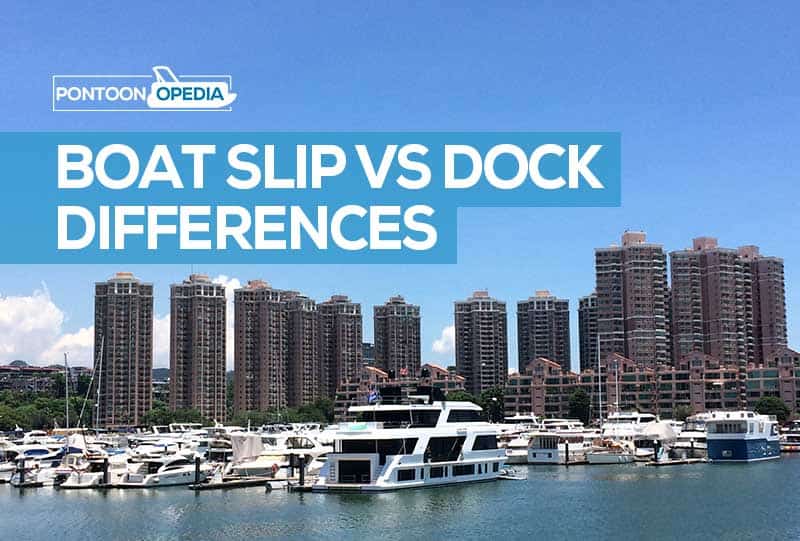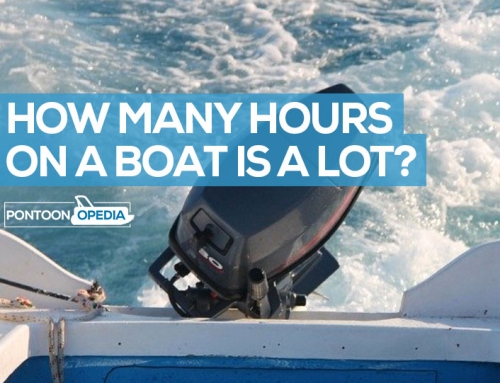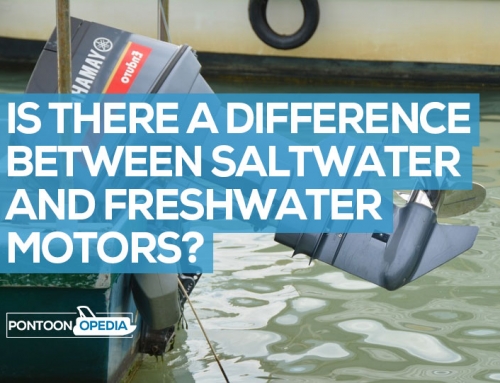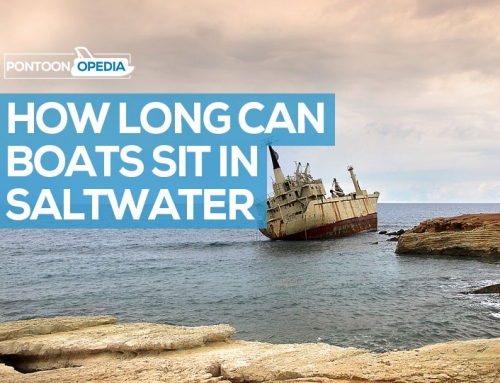The terms “boat slip” and “dock” are often used interchangeably but do actually mean two different things. When you pull a boat into a marina, you could be faced with a couple of choices, do you dock, or do you slip? But what are the differences between a boat slip versus a dock? Let’s find out.
What is a boat slip? Boat slips have just one open end, meaning the boat “slips” into it. The difference between boat slips and docks being docks having three open sides, as the boat positions “against” the side of the dock. Boat slips (aka dock slips) offer more protection, reducing the bumps that can happen in a traditional dock.
What does a boat slip look like?
Below you can see a photo of some boat slips in a residential marina. A boat slip resembles a single parking space while. A boat slip creates ‘’parking stalls’’ with each section normally contained on all 3 sides.
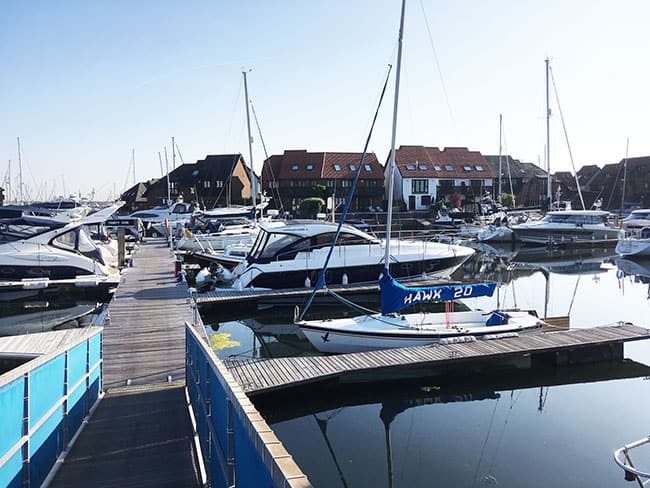
This is what a boat slip is and how it looks. Compare the differences to a boat dock further down the page.
In a boat slip, you place the boat between two walkways, with the 3rd one in front of it. The case is totally different with a boat dock, whereby the boat only has one side against the dock.
You will often find boat slips in marinas. It’s because they save on space, you can get more boats moored up, and the dock slips help to protect the boat, keeping it far more secure than a dock.
If the boat is moored well enough in the docking slip it can be position in the middle of space meaning there won’t be as many bumps and scrapes as you would get if positioned against a dock side.
What is a boat dock?
A boat dock is open on 3 sides, so the boat only docks against one strip of land. Docks aren’t as secure as boat slips as the protection from waves, bumps, and grinds isn’t there.
You are also limited to the number of boats that can dock, as the typically will park parallel to the dock side.
What does a dock look like?
Below you can see a photo of what a classic boat dock looks like, with this huge container ship parked up.
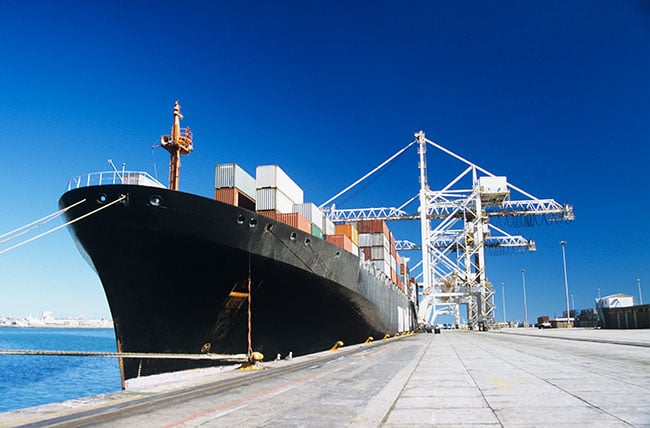
See how a boat dock is different to a boat slip. It’s open on all 3 sides.
Boat slip vs dock differences in detail
Let’s say you have just bought an expensive waterside property and own a boat. Should you dock against the side of the land, or invest some money in getting a boat slip or dock slip built?
One factor to consider the different types of boat or watercraft you’ll be using. A dock is the best option if you have a secluded area with just one boat. A boat slip is a better choice if you’re in a heavily utilized area with various different watercraft and might even have visitors needing to park up.
Boat slips are increasingly becoming popular among a good number of boat owners. This is especially true to those keen on having a more protected area to put their craft moored.
Let’s look at the differences between docking slips and traditional docks in a bit more detail.
Design differences
Boat slips are only open on one end to the water. Boat docks, on the other hand, have three sides open. The major difference between boat slips and docks is the former aren’t open in space compared to the latter.
Boat slips somewhat are akin to parking stalls for watercraft. Docks are more open and might only have a single large t-shaped section.
Marinas, as well as other locations, prefer the former for several reasons. Primarily, boat slips allow more craft to be moored together with a pier in comparison to the conventional docks.
Moreover, boat slips offer more mooring points thus resulting in a space that can hold the craft more securely.
Protection
Boat slips offer boats more protection from wave action compared to boat docks. Proper mooring means that a boat is more secure within the of the slip hence preventing extra grinding and bumping that might occur along the dock. The slips can mitigate wave action towards the particular shore they shelter.
With boat slips, boarding the craft is more secure. This feature is especially useful during the less than ideal water conditions. When you cover the boat slip, you can manage to protect your craft in the long-term from weather events such as storms and sun-induced fading.
Advantages
Compared to boat slips, boat docks are more affordable since they feature an easier and simpler construction (you might not even have to pay any money to even construction a dock). As aforementioned, they tend to be popular with homeowners since they are more flexible and take up less space.
When there’s more room available, a boat slip is the more advantageous. It allows for more areas for boat tethering thereby making sure your watercraft is more protected.
Boat slips boast the ability to hold a number of watercrafts that are equal to their size. Additionally, they make it safer and easier to board the boat.
Whether a boat slip or a boat dock is the best choice for your needs depends largely on the particular area you intend to build it in as well as the number and size of your boats.
How to choose the right boat slip
- Ease of docking: You need a boat slip that’s effortless to get in and out of with plenty of water for your draft. There should be a convenient hook-up for water, power etc.
- Water depth: Checking current water depth might reveal the slip assigned isn’t deep enough for your draft or keel. If you need or choose to dock stern first, you need adequate water on the slip’s inside end in order to clear your propellers. For accurate depth measurement, a long pole should be handy.
- Dock height: It is easier to get off and on the cockpit or side deck in marinas that have high fixed docks. For marinas with floating docks, it’s effortless to get off from the dock from larger powerboats. To reduce the difference in height, you might need to add a stool or ladder to the dock. With sail caddies, bow riders, and sailboats, the side deck is usually closer to the floating dock’s height.
- Finger length: This is another factor to consider depending on the location of the access point on your boat. If you are boarding onto the aft deck/cockpit or through a side gate, the dock’s length is less crucial compared to those that step off to a low floating dock.
- Approach momentum: If most of the time you dock with no current or wind, ideally, it is less stressful to dock on the dock’s approach side so that the fairway momentum brings you against the dock compared to pulling you away from the dock. Every time you dock with a prevailing wind, docking with the help of current or wind brings you to instead of away from the dock.
How to choose the right boat dock
- Needs analysis: What you intend to use your dock for is the first thing you need to consider when choosing the right boat dock. Your intended use should dictate style, shape, and size. For instance, will your sundeck accommodate many folks relaxing on the dock? If you are only utilizing the dock to access your boat, you might only need a straight and simple dock. Again, how many boats do you own? If you own multiple, then you need docks that make it effortless to get off and in your boats. If you intend to tie your watercraft up to your dock, ensure that the dock you create is longer than the boat. Additionally, it should be wide enough to allow room to set down a gear as well as for people to embark and get off the boat.
- Rules and regulations: There might be local or state restrictions and regulations that you’ll have to meet. For instance, some private lakes only permit floating docks set on floats or encapsulated foam drums. Therefore, you need to be familiar with all the rules and regulations regarding docking in your region. To be on the safe side, you can ask your neighbor or just look around to check whether there are any floating docks. If there aren’t, there is probably a reason. Installing a floating one or building a fixed dock might need a permit. If you happen to be a reservoir, perhaps you need to verify with two or even three regulating agencies. Most local municipalities dictate the size of a dock one can build. The last thing you want is to flaunt any regulation because you might end up having to grapple with a fine or remove the dock altogether.
- Accessories: You should consider what accessories or items the dock manufacturer provides such as steps, ladders, bumpers, or furniture in order to fully enjoy your dock. Some of the plush options include chair sets and space-saving table that mount of the dock’s side.
- Installation and maintenance: Installing heavier duty or high-profile docks needs several tools and can be done completely above water. If you’ll be removing the dock regularly, you need one that is not only lightweight but also easy to move.
The last word…
Elsewhere on Pontoonopedia there are a range of tutorials on how to park into boat slip and docks. I’ve listed a few of them below.

